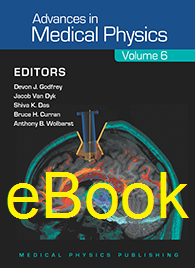
Advances in Medical Physics, Volume 6 (eBook)
Author: Devon J. Godfrey, Jacob Van Dyk, Shiva K. Das, Bruce H. Curran, and Anthony B. WolbarstISBN: 9781930524910
Published: 2016 July | 323 pp | eBook
Price: $ 90.00
Canadian Medical Physics News | Jan 2017
Advances in Medical Physics (Volume 6) is the most recent edition of a “biennial review of the treatments and techniques on the cutting edge of medical imaging and treatment” from Medical Physics Publishing. If you are familiar with the series, then this latest volume will be in keeping of the previous edition (Vol. 5) in terms of style, content, and intended audience. Generally, the series is aimed at educators, researchers, clinical medical physicists, biomedical engineers, and even physics enthusiasts to help them marshal through recent advances in imaging and therapeutics.
This volume is 323 pages long with 15 distinct and non-overlapping topics. Chapters in the book are organized by topic, providing the reader the opportunity to read chapters of interest a la carte. Topics range from more “traditional” medical physics (advances in ultrasound imaging, brachytherapy, HIFU), to more specialized techniques (spectral imaging with CT, targeted alpha therapy, photoacoustic imaging, design and development of linac-MR hybrids, applications of Cherenkov emissions, small animal radiotherapy and imaging), plus some didactic and general interest topics for medical physicists (see later in this review). Some chapters are quite short (6 – 14 pages), whereas others are longer (30 – 32 pages). Each chapter ends with a lengthy list of references, which is helpful for the a la carte reader.
In terms of complexity, there are enough equations peppered throughout the book such that it could only be appreciated by an audience well versed in mathematics and physics.
In keeping with the stylist changes introduced in Volume 5, the margins are tight (less than 2 cm along the edges, approximately 11pt serif font, printed on 8”x11” pages), which can make the text “busy” for some. Each chapter has both colorized and black/ white figures and tables. While the uses of colorized figures are greatly appreciated, figures within chapters often have different resolutions such that some figures are very high quality and others are not. This can be distracting at times, but not prohibitively so. Each chapter reads with a similar trajectory in relaying content: a broad introduction, definitions of scope and goals in the chapter, the content, and a summary often with future directions. Overall, writing styles change between chapters due to the fact that each chapter is prepared by different authors. All chapters are well written but some are easier to read than others (a notable mention is Chapter 4: Advances in Ultrasound Imaging).
Some highlights and interesting chapters are as follows. Dr Jerry Battista provides a chapter exploring the analogy of MR and linac physics with guitars (Chapter 7: The Physics of MRI and Linacs: Music to My Ears), and another chapter exploring the radiation risks of inter-planetary space travel (Chapter 13: Radiation Exposure on a Voyage to Mars: All Aboard?). While these are not necessarily “advances” in medical physics, the topics are in keeping in the traditions of previous editions for providing interesting and well written content. Chapter 10: Advances in Brachytherapy Physics nicely balances historical developments of brachytherapy physics with recent developments while providing clinically useful equations and content. Some helpful definitions and equations in practical radiobiology are provided in Chapter 12: Radiobiological Aspects of Some Current Issues in Radiation Oncology, Medical Physics, and Radiological Protection. While lengthy (30 pages), Chapter 6: Design and Development of Linac-MR Hybrids will be helpful for many medical physicists in preparing for the wave of MR-linac technologies. And while short (6 pages), Chapter 14: EPA’s Federal Guidance Authority and Recent Guidance on Radiation Protection for Diagnostic and Interventional X-ray Procedures provides a concise history of the topic along with some bullet point recommendations for federal agencies.
I took the effort of reviewing all 96 chapter titles in the previous five editions to see how much content might have been repeated or recycled. With the exception of (expected) updates in image guided therapeutics and possibly some content on radiation safety, there is surprisingly very little repeated content over 10 years. The editorial task of collating and presenting unique medical physics topics is a challenging one, and the editors should be commended for successfully doing this again. One subtle issue is that while a chapter might describe a particular type of technique or technology, authors tend not to compare or contrast their technique or technology with competing ones.
This is a good series for medical physics learners and this edition is no exception. If you are a clinical medical physicist, you will find many of the chapters useful. If you teach medical physics at the undergraduate or graduate level, this book may be useful for keeping your general medical physics “chops” up to date and providing fresh content for survey courses in medical physics. The book will be useful for academic medical physicists interested in exploring new research topics since each chapter easily initiates the reader with the new content and references.
You may be pleased to learn that both a soft cover and an eBook are once again available for purchase; however, I struggle to understand why (again) the eBook is the same price as the soft cover. The golden question for many medical physicists is if it is worth 90USD of their precious professional allowance funds. I won’t answer that, but I will say that this volume has high quality content that is well presented by experts, with a plethora of figures, tables, and references. If you have not updated your textbook library in the last five years and are looking to update your medical physics knowledge base, this book will be useful and is of reasonably good value.
Parminder S. Basran, BC Cancer Agency
Editor’s Note: Here is a link to an article about the publication of this book : http://www.schulich.uwo.ca/gradstudies/about_us/monthly_newsletter/2016/november/advancing_medical_physics_one_page_at_a_time.html


